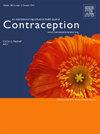Comparative performance of ultrathin and standard latex condoms: A randomized multicentre trial
IF 2.3
2区 医学
Q1 OBSTETRICS & GYNECOLOGY
引用次数: 0
Abstract
Objectives
This study aimed to assess the performance of a natural rubber latex condom with a thickness of 42 µm, compared with two currently marketed alternatives.
Study design
In this blinded, three-way crossover, multicentre study, across four sites in Thailand, couples were randomized to receive one of three thicknesses of condom (42, 55, or 70 µm) at first visit. Couples received the remaining condoms at visits two and three, respectively. Participants were given seven condoms at each visit and asked to use at least five condoms of each thickness and report any clinical failures (slippage or breakage during intercourse or withdrawal from the vagina). Participants recorded adverse events and clinical failures within 2 hours of use.
Results
A total of 225 couples completed the study. Clinical failure rates were 1.37% (95% confidence intervals [CIs] 0.78, 2.22) in the 42 µm group, 2.12% (95% CI 1.38, 3.11) in the 55 µm group, and 1.68% (95% CI 1.03, 2.58) in the 70 µm group. The 42 µm condom was noninferior compared with each of the reference condoms and had a similar safety profile.
Conclusions
This ultrathin, natural rubber latex condom of <50 µm has been clinically tested to current International Organization for Standardization standards. The 42 µm condom was as effective as the 55 and 70 µm condoms, demonstrating that performance in terms of failure rate, slippage, or breakage was not altered by its thinness.
Implications
This ultrathin NRL condom of <50 µm has been clinically tested to current International Organization for Standardization standards. This could help to ease concerns about whether ultrathin condoms might compromise reliability and increase failure rate.
超薄和标准乳胶避孕套的比较性能:一项随机多中心试验。
目的:本研究旨在评估厚度为42 μ m的天然胶乳(NRL)避孕套的性能,并与目前两种已上市的替代品进行比较。研究设计:在这项盲法、三向交叉、多中心的研究中,在泰国的四个地点,夫妇在第一次访问时随机接受三种厚度的避孕套(42微米、55微米或70微米)中的一种。夫妇们分别在第二次和第三次访问时收到了剩余的避孕套。参与者在每次访问中获得7个避孕套,并被要求使用每种厚度的至少5个避孕套,并报告任何临床失败(性交时滑脱或破裂或从阴道取出)。参与者在使用两小时内记录了不良事件和临床失败。结果:225对夫妇完成了这项研究。42µm组临床失败率为1.37%(95%可信区间[CI] 0.78, 2.22), 55µm组为2.12% (95% CI 1.38, 3.11), 70µm组为1.68% (95% CI 1.03, 2.58)。42µm的避孕套与每一个参考避孕套相比都没有差,并且具有相似的安全性。结论:该超薄,NRL避孕套
本文章由计算机程序翻译,如有差异,请以英文原文为准。
求助全文
约1分钟内获得全文
求助全文
来源期刊

Contraception
医学-妇产科学
CiteScore
4.70
自引率
17.20%
发文量
211
审稿时长
69 days
期刊介绍:
Contraception has an open access mirror journal Contraception: X, sharing the same aims and scope, editorial team, submission system and rigorous peer review.
The journal Contraception wishes to advance reproductive health through the rapid publication of the best and most interesting new scholarship regarding contraception and related fields such as abortion. The journal welcomes manuscripts from investigators working in the laboratory, clinical and social sciences, as well as public health and health professions education.
 求助内容:
求助内容: 应助结果提醒方式:
应助结果提醒方式:


